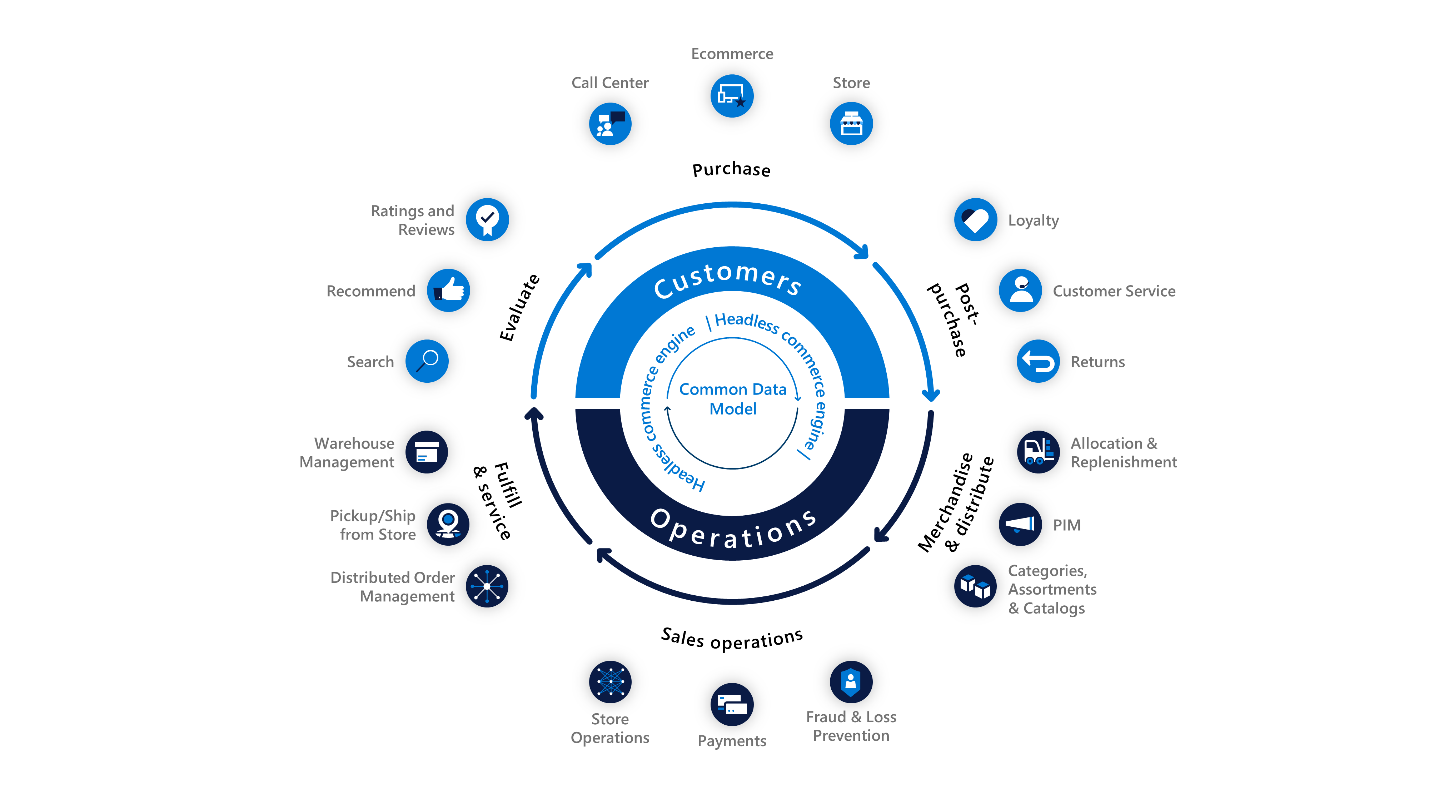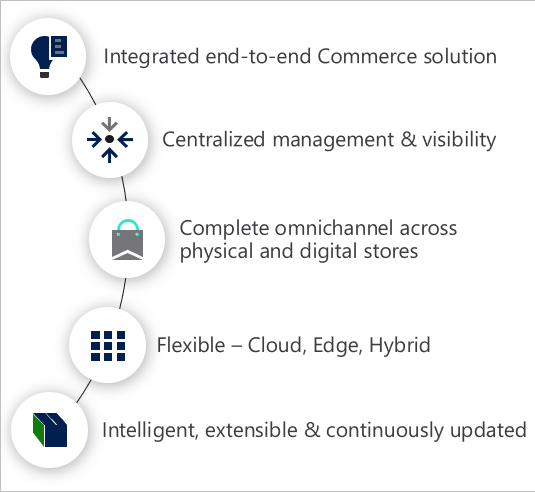Describe Commerce core capabilities
Commerce delivers a set of capabilities that organizations can implement to create a comprehensive omnichannel solution. This solution unifies back-office, in-store, call center, and digital experiences on a single platform. You can use Commerce to build brand loyalty through personalized customer engagements, increase revenue with improved employee productivity, optimize operations to reduce costs, and drive supply chain efficiency. Commerce includes features like sales, mobility, intelligence, and productivity, and helps to achieve more in a cloud-first manner.
Commerce offers several capabilities to support the shopping life cycle, as illustrated in the following diagram.

The capabilities are all centered around a common data model and a Commerce engine that allows the organization to execute a consistent set of business rules across multiple selling channels.
The following illustration depicts the technical capabilities of Commerce to achieve that functionality.

Commerce provides organizations with the ability to manage all core business data. This data includes products, prices and promotions, inventory, order management, order fulfillment, and financials. Commerce integrates with other Dynamics 365 and Microsoft productivity solutions. For example, Commerce can be combined with Microsoft Power Platform to deliver analytics and business workflow orchestration. Commerce can also be integrated with Microsoft Teams to facilitate task management execution and communications across distribution centers and stores. Organizations can also optionally deploy Microsoft Intelligent Recommendations and Dynamics 365 Fraud Protection services to further enhance the experience.
The core components of the Commerce application are:
Commerce Headquarters
Commerce Scale Unit
E-commerce Storefront
Site Builder
Store Commerce
Commerce headquarters
The Commerce application, which is often referred to as the Commerce headquarters component, provides back-office capabilities for the business. Those capabilities enable the configuration of products, employees, business processes, and other required functionality. It's also the application that call center workers use to provide assisted commerce-related workflows. Commerce inherently uses some of the core capabilities found in the Dynamics 365 Supply Chain Management and Dynamics 365 Finance applications. Organizations may optionally license and deploy these other Supply Chain Management and Finance components alongside Commerce. Those components offer even more advanced Supply Chain Management and Finance capabilities that aren't provided with the standard Commerce license.
Commerce Scale Unit
The Commerce Scale Unit hosts the headless commerce engine. It serves as the central integration point for all commerce business logic and powers a complete omni-channel solution across physical and digital stores. With the headless architecture, the front end can be decoupled from the back end commerce functionality via API. This decoupling allows for a portable architecture with a more agile approach for the implementation of the omnichannel touchpoints. This architecture allows for flexible hosting options across cloud and hybrid topologies.
The Commerce Scale Unit also serves as the single integration point for third-party channel solutions. Therefore, those solutions can take advantage of the power of Commerce business logic and integration with other commerce-related services that are provided by Microsoft and independent software vendors (ISVs).
E-commerce Storefront
The e-commerce storefront is the customer-facing website-rendering system. It's built on the React.js framework and uses a combination of server-side and client-side rendering to deliver responsive web experiences for one or more online channels. Although the storefront has a rich set of out-of-box capabilities, it's also highly customizable, and delivers an efficient and scalable solution for online business.
Site builder
Site builder is a web-based authoring interface for content management and storefront website-rendering systems. Visual page builder in site builder is a what-you-see-is-what-you-get (WYSIWYG) editor for site managers and content authors who perform the day-to-day workflow tasks of managing and producing the marketing content for the e-commerce experience. In site builder, a marketer can provide more marketing detail for specific products to enhance the shopping experience for consumers. In addition, site builder includes integrated accessibility reporting, URL management, site map generation, and image focal point management, among other features.
Store Commerce
Store Commerce is a cross-platform (Windows, iOS, and Android), multiform factor (desktop, tablet, and phone) solution for all in-store Firstline Workers. Firstline Workers include cashiers, sales associates, stock clerks, and store managers. It can be deployed as an app that has offline capabilities. Alternatively, it can be deployed in the cloud and accessed through a web browser. The application is role-based and fully configurable from headquarters. It's also highly customizable and can be extended or integrated into third-party services by using the provided Software Development Kit (SDK).
In addition to standard "cash and carry" transaction processing, Store Commerce includes features for assisted selling, order processing/fulfillment, inventory management, cash/shift management, and reporting. Store Commerce also includes the clienteling feature, which helps to establish long-term relationships with customers.
Let’s consider an example. You own a bicycle company, VanArsdel, Ltd, and have been in business for five years. It started as a small brick-and-mortar bike shop, but to keep up with modern times, you invested in e-commerce. The basic e-commerce software was working well in the beginning, but business has expanded over the years, and your customers are becoming more demanding. Customers have a desire to buy online and pick up in store, or easily return their online purchases to a local store location. You're also finding it hard to accurately maintain the data about your products and orders in multiple transactional systems. It’s time to consider something more robust that can be tailored to your business needs. You want to be able to unify your product data and your sales transaction data for VanArsdel's products across multiple retail channels, including the ability to create special pricing or discounts for specific channels.